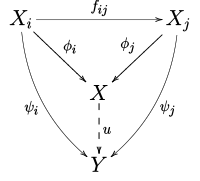Direct limits of algebraic objects
In this section objects are understood to consist of underlying sets equipped with a given algebraic structure, such as groups, rings, modules (over a fixed ring), algebras (over a fixed field), etc. With this in mind, homomorphisms are understood in the corresponding setting (group homomorphisms, etc.).
Let  be a directed set. Let
be a directed set. Let  be a family of objects indexed by
be a family of objects indexed by  and
and  be a homomorphism for all
be a homomorphism for all  with the following properties:
with the following properties:
 is the identity on
is the identity on  , and
, and for all
for all  .
.
Then the pair  is called a direct system over
is called a direct system over  .
.
The direct limit of the direct system  is denoted by
is denoted by  and is defined as follows. Its underlying set is the disjoint union of the
and is defined as follows. Its underlying set is the disjoint union of the  's modulo a certain equivalence relation
's modulo a certain equivalence relation  :
:

Here, if  and
and  , then
, then  if and only if there is some
if and only if there is some  with
with  and
and  such that
such that  . Intuitively, two elements in the disjoint union are equivalent if and only if they "eventually become equal" in the direct system. An equivalent formulation that highlights the duality to the inverse limit is that an element is equivalent to all its images under the maps of the direct system, i.e.
. Intuitively, two elements in the disjoint union are equivalent if and only if they "eventually become equal" in the direct system. An equivalent formulation that highlights the duality to the inverse limit is that an element is equivalent to all its images under the maps of the direct system, i.e.  whenever
whenever  .
.
One obtains from this definition canonical functions sending each element to its equivalence class. The algebraic operations on
sending each element to its equivalence class. The algebraic operations on  are defined such that these maps become homomorphisms. Formally, the direct limit of the direct system
are defined such that these maps become homomorphisms. Formally, the direct limit of the direct system  consists of the object
consists of the object  together with the canonical homomorphisms
together with the canonical homomorphisms  .
.
Direct limits in an arbitrary category
The direct limit can be defined in an arbitrary category  by means of a universal property. Let
by means of a universal property. Let  be a direct system of objects and morphisms in
be a direct system of objects and morphisms in  (as defined above). A target is a pair
(as defined above). A target is a pair  where
where  is an object in
is an object in  and
and  are morphisms for each
are morphisms for each  such that
such that  whenever
whenever  . A direct limit of the direct system
. A direct limit of the direct system  is a universally repelling target
is a universally repelling target in the sense that
in the sense that  is a target and for each target
is a target and for each target  , there is a unique morphism
, there is a unique morphism  such that
such that  for each i. The following diagram
for each i. The following diagram

will then commute for all i, j.
The direct limit is often denoted

with the direct system  and the canonical morphisms
and the canonical morphisms  (or, more precisely, canonical injections
(or, more precisely, canonical injections  ) being understood.
) being understood.
Unlike for algebraic objects, not every direct system in an arbitrary category has a direct limit. If it does, however, the direct limit is unique in a strong sense: given another direct limit X′ there exists a unique isomorphism X′ → X that commutes with the canonical morphisms.







































































